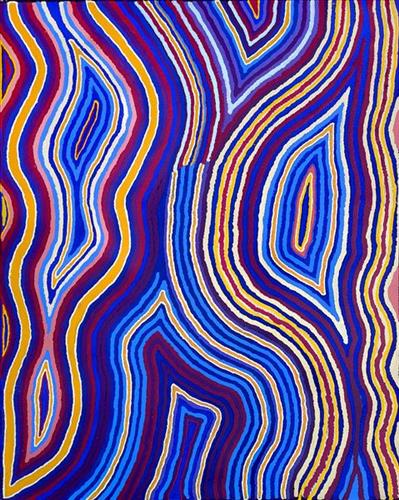114182275289
Kungkarrangkalpa (Seven Sisters)
In this painting, Angilyiya is focusing on the man — these are his eyes staring at you.
‘Kungkarrangkalpa’ (The Seven Sisters or Pleiades) is significant Tjukurrpa (Dreamtime). Its origins may be familiar to you in astronomy, through its connection to Wati Nyiru (Magic Man or Orion). The roots of this dreaming stretch across many Indigenous cultures around the world. The Australian Aboriginal songline is just one part of this larger dreaming that can be traced globally. For the ladies of the Ngaanyatjarra Lands, this story carries a particular chapter — one tied deeply to their understanding of country and the journey of the sisters. The different versions of this story depend on where you live and the importance of local Tjukurrpa places.
Nyiru fell in love with the sisters but was the wrong skin group to marry them. Still, he pursued them relentlessly. The sisters travel across the land to escape Nyiru’s unwanted attentions, always just out of reach. Their path can still be read in the land today — rocks, caves, and waterholes that carry this memory. As Nyiru is chasing the sisters he tries to catch them by using magic to turn into the most tempting kampurarrpa (bush tomato) and the most beautiful Yirli (wild fig tree), for them to eat and camp under. However, the sisters are knowledgeable of his magic and too clever for Nyiru, who they outwit again and again. They go hungry and run through the night rather than be caught by him. As the journey continues, Nyiru gets so frustrated at the wit of the sisters that he uses his magic to make the oldest sister sick to try and get closer to her. The other sisters rescue the big sister and nurse her back to health. It is said he also captures the youngest sister, but with the help of the oldest sister, she escapes back to her sisters who are waiting for her. Eventually, the sisters fly into the sky to escape Nyiru, forming the constellation. Nyiru, heartbroken and longing, used his magic to follow them — and now chases them forever across the sky.
This painting maps the site of Kuru Ala — meaning “two eyes”, a women’s site in Angilyiya’s mother’s country south of Papulankutja (Blackstone). Here, Wati Nyiru was spying on the women, watching them from the shadows of the cave — disguised as a quandong tree, a fig tree, then a snake — as they camped and dug for food.





